NLMEResults
Results object containing estimation results from nonlinear mixed-effects modeling
Description
The NLMEResults object contains estimation results from fitting
a nonlinear mixed-effects model using sbiofitmixed.
Creation
Use the sbiofitmixed function to create an
NLMEResults object.
Properties
Table of the estimated fixed effects and their standard errors, specified as a table.
Table of the estimated random effects for each group, specified as a table.
Table of estimated parameter values, including fixed and random effects, specified as a table.
Table of estimated parameter values, including only fixed effects, specified as a table.
Table of the covariance matrix of the random effects, specified as a table.
Covariate names, specified as a cell array of character vectors.
Data used for fitting, specified as a groupedData object.
This Data property contains a
copy of groupedData specified as the input data in
the sbiofitmixed call or the
Data
property of a fitproblem
object.
Estimated parameter names, specified as a cell array of character vectors.
Table describing the error models and estimated error model parameters, specified as a table.
The table has one row with three variables: ErrorModel,
a, and b. The ErrorModel
variable is categorical. The variables a and b can
be NaN when they do not apply to a particular error model.
There are four built-in error models. Each model defines the error using a standard mean-zero and unit-variance (Gaussian) variable e, the function value f, and one or two parameters a and b. In SimBiology®, the function f represents simulation results from a SimBiology model.
'constant':'proportional':'combined':'exponential':
Name of the estimation function, specified as 'nlmefit' or
'nlmefitsa'.
Maximized loglikelihood for the fitted model, specified as a scalar.
Akaike Information Criterion (AIC), specified as a scalar. The AIC is calculated as
AIC = 2*(-LogLikelihood + P), where P is the
number of parameters. For details, see nlmefit (Statistics and Machine Learning Toolbox).
Bayes Information Criterion (BIC), specified as a scalar. The BIC is calculated as
BIC = -2*LogLikelihood + P*log(N), where N is
the number of observations or groups, and P is the number of
parameters. For details, see nlmefit (Statistics and Machine Learning Toolbox).
Degrees of freedom for error (DFE), specified as a scalar. The DFE is calculated as
DFE = N-P, where N is the number of observations
and P is the number of parameters.
Note
If you are using the nlmefitsa method,
Loglikelihood, AIC, and BIC
properties are empty by default. To calculate these values, specify the
'LogLikMethod' option of nlmefitsa (Statistics and Machine Learning Toolbox) when you run sbiofitmixed as follows.
opt.LogLikMethod = 'is'; fitResults = sbiofitmixed(...,'nlmefitsa',opt);
Object Functions
boxplot | Create box plot showing the variation of estimated SimBiology model parameters |
covariateModel | Return a copy of the covariate model that was used for the nonlinear mixed-effects
estimation using sbiofitmixed |
fitted | Return the simulation results of a fitted nonlinear mixed-effects model |
plot | Compare simulation results to the training data, creating a time-course subplot for each group |
plotActualVersusPredicted | Compare predictions to actual data, creating a subplot for each response |
plotResidualDistribution | Plot the distribution of the residuals |
plotResiduals | Plot the residuals for each response, using the time, group, or prediction as the x-axis |
predict | Simulate and evaluate fitted SimBiology model |
random | Simulate a SimBiology model, adding variations by sampling the error model |
Examples
This example uses data collected on 59 preterm infants given phenobarbital during the first 16 days after birth [1]. Each infant received an initial dose followed by one or more sustaining doses by intravenous bolus administration. A total of between 1 and 6 concentration measurements were obtained from each infant at times other than dose times, for a total of 155 measurements. Infant weights and APGAR scores (a measure of newborn health) were also recorded.
Load the data.
load pheno.mat ds
Convert the dataset to a groupedData object, a container for holding tabular data that is divided into groups. It can automatically identify commonly used variable names as the grouping variable or independent (time) variable. Display the properties of the data and confirm that GroupVariableName and IndependentVariableName are correctly identified as 'ID' and 'TIME', respectively.
data = groupedData(ds); data.Properties
ans = struct with fields:
Description: ''
UserData: []
DimensionNames: {'Observations' 'Variables'}
VariableNames: {'ID' 'TIME' 'DOSE' 'WEIGHT' 'APGAR' 'CONC'}
VariableTypes: ["double" "double" "double" "double" "double" "double"]
VariableDescriptions: {}
VariableUnits: {}
VariableContinuity: []
RowNames: {}
CustomProperties: [1×1 matlab.tabular.CustomProperties]
GroupVariableName: 'ID'
IndependentVariableName: 'TIME'
Create a simple one-compartment PK model with bolus dosing and linear clearance to fit such data. Use the PKModelDesign object to construct the model. Each compartment is defined by a name, dosing type, a clearance type, and whether or not the dosing requires a lag parameter. After constructing the model, you can also get a PKModelMap object map that lists the names of species and parameters in the model that are most relevant for fitting.
pkmd = PKModelDesign; addCompartment(pkmd,'Central','DosingType','Bolus',... 'EliminationType','linear-clearance',... 'HasResponseVariable',true,'HasLag',false); [onecomp, map] = pkmd.construct;
Describe the experimentally measured response by mapping the appropriate model component to the response variable. In other words, indicate which species in the model corresponds to which response variable in the data. The PKModelMap property Observed indicates that the relevant species in the model is Drug_Central, which represents the drug concentration in the system. The relevant data variable is CONC, which you visualized previously.
map.Observed
ans = 1×1 cell array
{'Drug_Central'}
Map the Drug_Central species to the CONC variable.
responseMap = 'Drug_Central = CONC';The parameters to estimate in this model are the volume of the central compartment Central and the clearance rate Cl_Central. The PKModelMap property Estimated lists these relevant parameters. The underlying algorithm of sbiofit assumes parameters are normally distributed, but this assumption may not be true for biological parameters that are constrained to be positive, such as volume and clearance. Specify a log transform for the estimated parameters so that the transformed parameters follow a normal distribution. Use an estimatedInfo object to define such transforms and initial values (optional).
map.Estimated
ans = 2×1 cell
{'Central' }
{'Cl_Central'}
Define such estimated parameters, appropriate transformations, and initial values.
estimatedParams = estimatedInfo({'log(Central)','log(Cl_Central)'},'InitialValue',[1 1]);Each infant received a different schedule of dosing. The amount of drug is listed in the data variable DOSE. To specify these dosing during fitting, create dose objects from the data. These objects use the property TargetName to specify which species in the model receives the dose. In this example, the target species is Drug_Central, as listed by the PKModelMap property Dosed.
map.Dosed
ans = 1×1 cell array
{'Drug_Central'}
Create a sample dose with this target name and then use the createDoses method of groupedData object data to generate doses for each infant based on the dosing data DOSE.
sampleDose = sbiodose('sample','TargetName','Drug_Central'); doses = createDoses(data,'DOSE','',sampleDose);
Fit the model.
[nlmeResults,simI,simP] = sbiofitmixed(onecomp,data,responseMap,estimatedParams,doses,'nlmefit');Visualize the fitted results using individual-specific parameter estimates.
plot(nlmeResults,'ParameterType','individual');
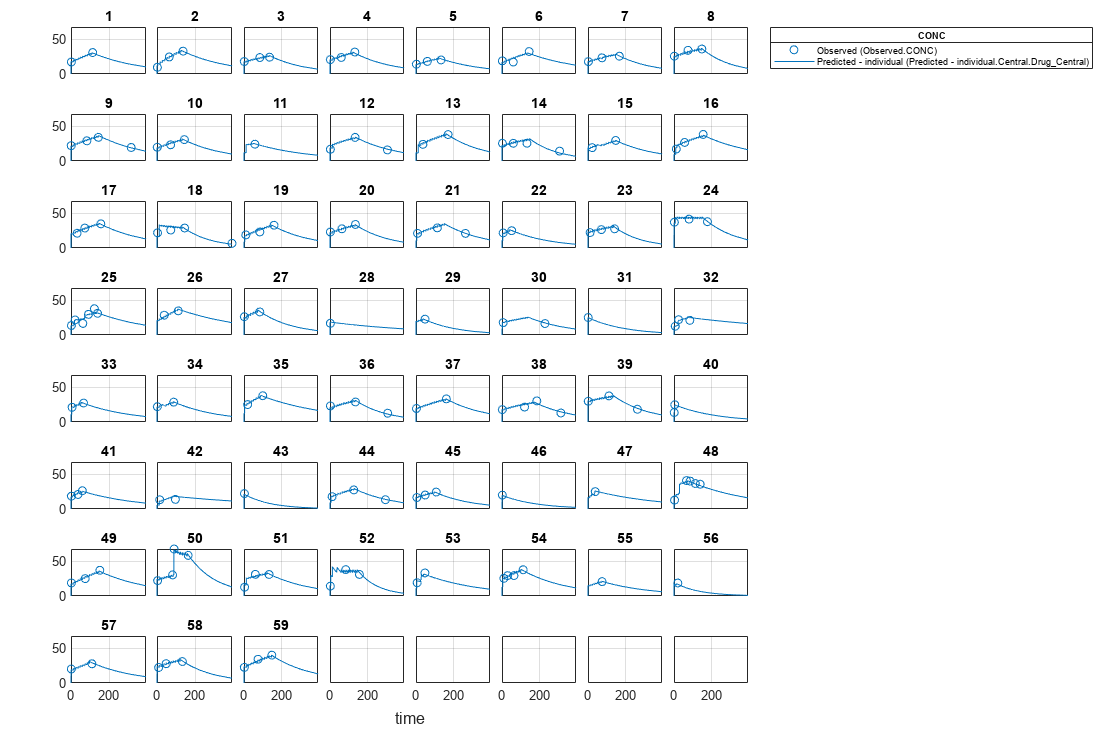
Visualize the fitted results using population parameter estimates.
plot(nlmeResults,'ParameterType','population');
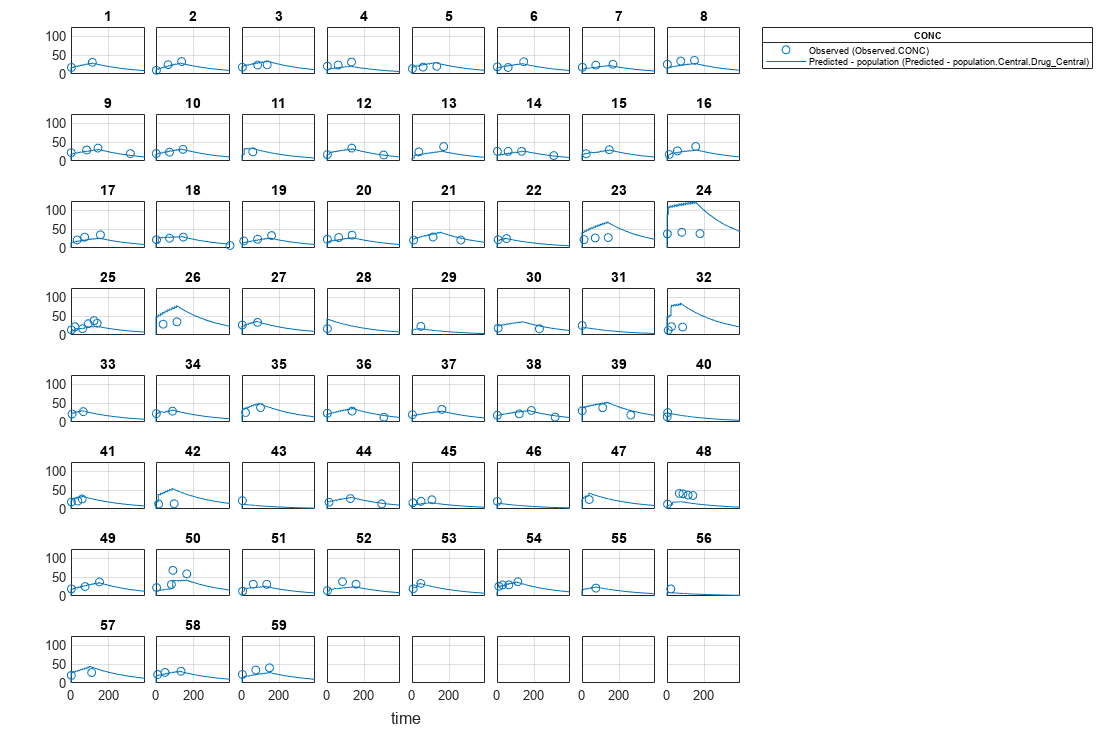
Display the variation of estimated parameters using boxplot.
boxplot(nlmeResults)

Compare the model predictions to the actual data.
plotActualVersusPredicted(nlmeResults)
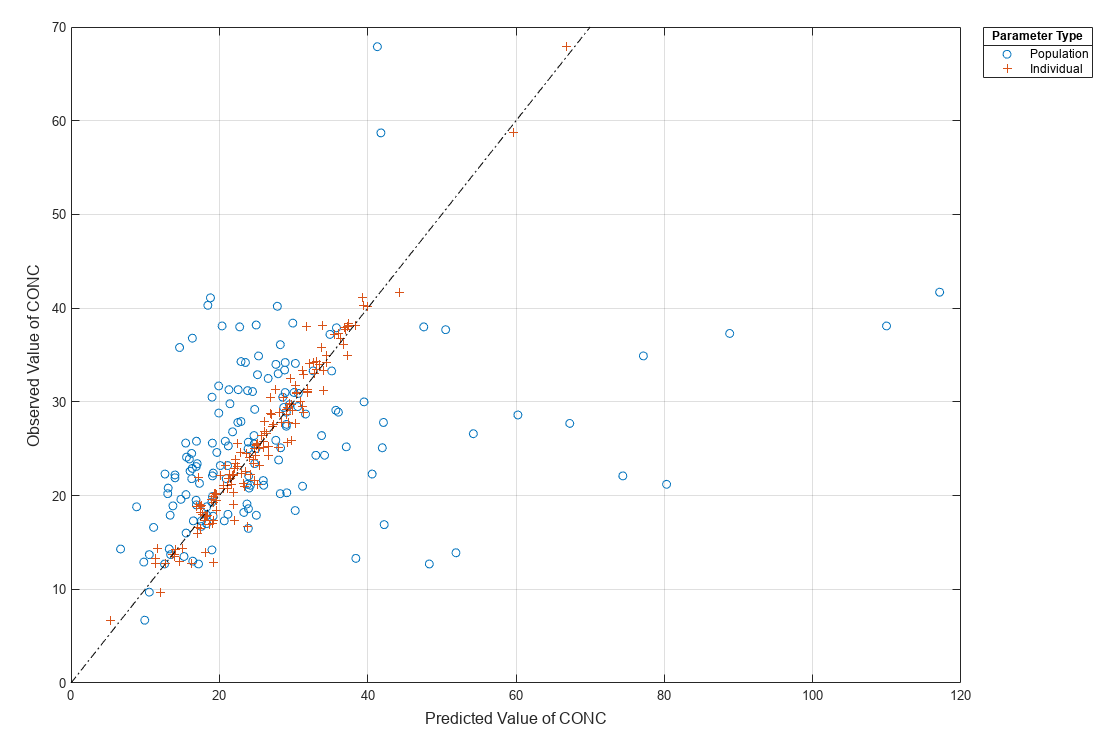
Plot the distribution of residuals.
plotResidualDistribution(nlmeResults)
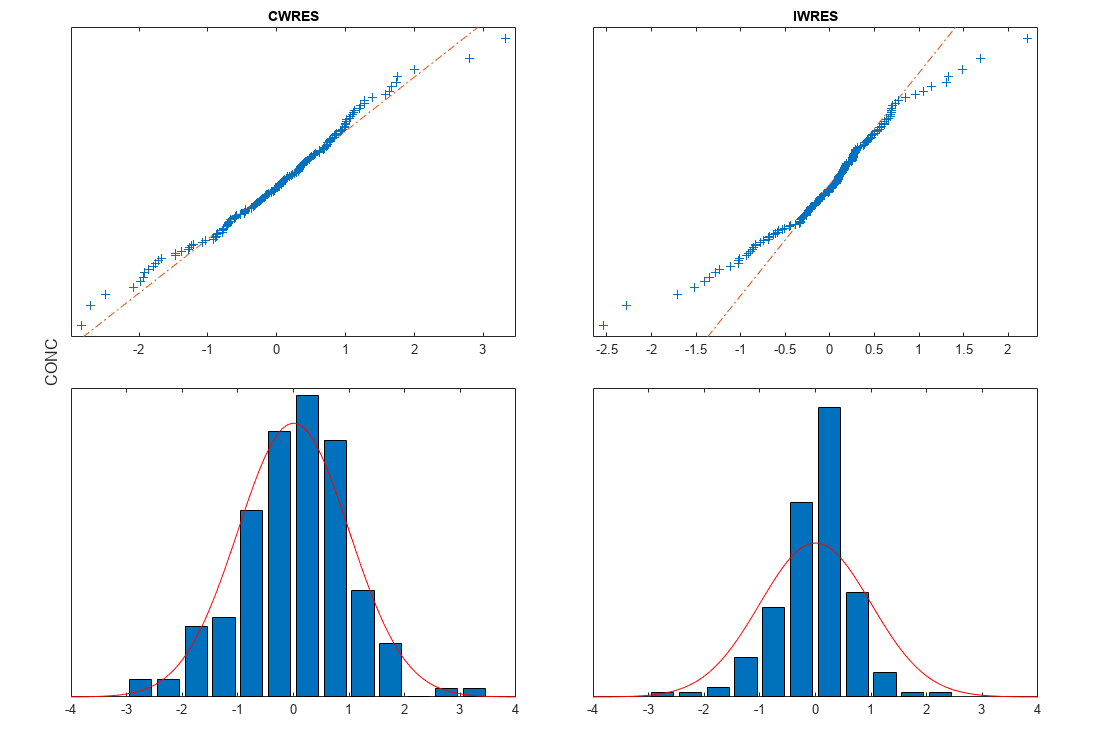
Plot residuals for each response using the model predictions on x-axis.
plotResiduals(nlmeResults,'Predictions')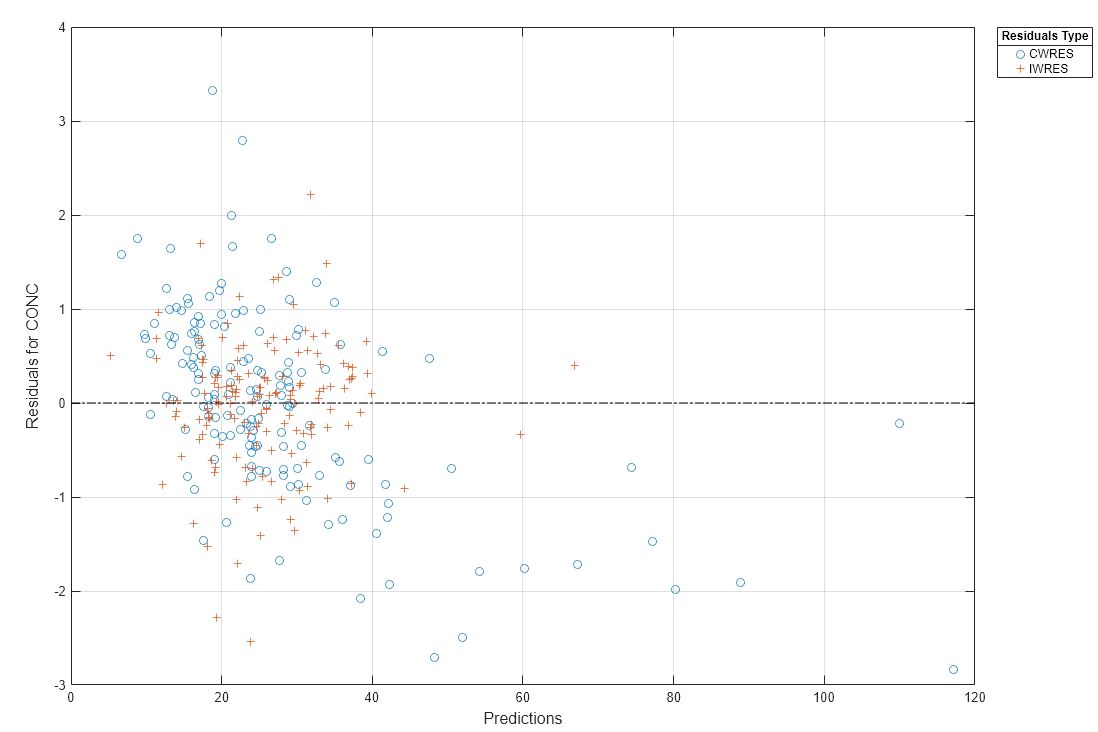
Version History
Introduced in R2014a
See Also
sbiofitmixed | sbiofit | nlmefit (Statistics and Machine Learning Toolbox) | nlmefitsa (Statistics and Machine Learning Toolbox)
MATLAB Command
You clicked a link that corresponds to this MATLAB command:
Run the command by entering it in the MATLAB Command Window. Web browsers do not support MATLAB commands.
选择网站
选择网站以获取翻译的可用内容,以及查看当地活动和优惠。根据您的位置,我们建议您选择:。
您也可以从以下列表中选择网站:
如何获得最佳网站性能
选择中国网站(中文或英文)以获得最佳网站性能。其他 MathWorks 国家/地区网站并未针对您所在位置的访问进行优化。
美洲
- América Latina (Español)
- Canada (English)
- United States (English)
欧洲
- Belgium (English)
- Denmark (English)
- Deutschland (Deutsch)
- España (Español)
- Finland (English)
- France (Français)
- Ireland (English)
- Italia (Italiano)
- Luxembourg (English)
- Netherlands (English)
- Norway (English)
- Österreich (Deutsch)
- Portugal (English)
- Sweden (English)
- Switzerland
- United Kingdom (English)